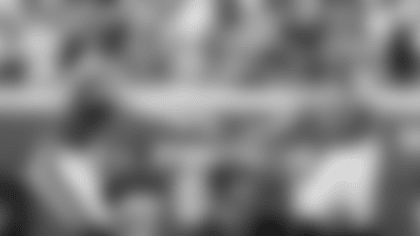Join *Jaguars Inside Report *Senior Editor Vic Ketchman as he tackles the fans' tough questions.
Keith Johnson from Jacksonville:
Why can't the Jaguars use the draft model used by the Baltimore Ravens and St. Louis Rams with success, where they would spend their entire draft on one side of the ball one season and then spend the next season's draft on the other side of the ball? Baltimore used this approach to get people like Ray Lewis, Jamie Sharper, etc., and the Rams used this approach to greatly shore up their defense last season. Both teams went to the Super Bowl. Why can't the Jags use their entire draft this year for defense, take a hit for 2002, then use the entire 2003 draft for offense, assuming no major injuries?
Vic:
Why would you want to eliminate half the draft pool from your list of candidates? Your "facts" on Baltimore are not correct. In the year they drafted Ray Lewis (1996), they also drafted Jonathan Ogden with their first pick. In the year they drafted Jamie Sharper ('97), they also drafted Peter Boulware and Kim Herring, but I would hardly describe that as selling out for defense. In 2000, the Ravens clearly addressed needs on offense by selecting Jamal Lewis and Travis Taylor in the first round, and Lewis became a difference-maker as a rookie, but Taylor was no factor in the Ravens' run to the Super Bowl title. St. Louis sold out for defense in last year's draft, selecting Damione Lewis, Adam Archuleta and Ryan Pickett in the first round. Archuleta was a difference-maker, but the Rams' most important acquisition on defense was veteran cornerback Aeneas Williams. The Jaguars' needs are too many to pass on a star prospect by focusing on the other side of the ball. Forget about models. Successful teams create their own models.
Bill Cavanaugh from Jacksonville:
Is it looking more and more likely the Jags will "trade down" in the first round in order to receive more picks in the middle rounds? What is your personal opinion on this scenario? Also, in your opinion, is the money saved by releasing Keenan McCardell after June 1 "really" worth losing such a player?
Vic:
Have we already forgotten what a desperate situation the Jaguars' salary cap had become? Difficult and unpopular decisions had to be made. The team clearly had decided to keep contract re-structuring to a minimum. How can you argue with that, since re-structuring got them one fewer win in 2001? Trading down to gain draft choices is an idea worth entertaining, however, in the Jaguars' case it would mean dropping out of the top 10, and any personnel man will tell you there is a significant drop-off in talent after the top 10 picks. It might be in the Jaguars' best interest to resist the temptation to trade down, provided they believe the player available to them with the ninth pick is true quality. My instincts say take the "sure" thing. Everybody wants to get wild and crazy with the draft because it's fun to play the draft games, but this is no joke. This is the future of this team.
Trey Mills from Atlanta, GA:
I know this is not a question, and I'm beating a dead horse here, but this is driving me crazy. You seem to be riding the fence on the issue of re-structuring contracts. Before the Jags started re-structuring this year, you said they should not re-structure contracts at all anymore. Now, you are saying it's OK as long as the money being pushed back is used to sign a few players instead of a single one. The players we are signing are nowhere close to impact players. Coughlin seems to be doing the same thing (bringing in players from his old school) that Spurrier is being ridiculed for in D.C.
Vic:
No fence-sitting here; I am totally against the practice of re-structuring contracts, but, again, we are forgetting the desperate salary cap situation the Jaguars faced. I would've preferred they bite the bullet totally in 2002 so that no money would be pushed onto future caps, but they decided the "bite" would be too severe. They re-structured Tony Brackens and Kyle Brady. That's two players. Consider a year ago, when this team re-structured every player on the roster who would offer a salary cap gain. In attempting to appreciate the upside of the Jaguars' decision to re-structure Brackens and Brady, I offered the fact that the money saved was not then given to a high-priced free agent in a $6 million signing bonus. Brackens was re-structured so the Jaguars could match a reasonable contract offer Jason Craft had received from New Orleans. Brady was re-structured so the Jaguars could sign Patrick Johnson to a minimum-wage contract with a $100,000 signing bonus; very little cap risk there. In the past, the Jaguars had re-structured several high-priced players so they could sign one free agent. That was not the case with Craft and Johnson. What it all tells me is the Jaguars have learned their lesson, their intent on not making the same mistakes again, and even though the concept of re-structuring contracts sends chills down my spine, I'm satisfied the Jaguars are acting in a fiscally responsible way.
Ryan Glenn from Atlanta, GA:
Keenan McCardell came to the Jags as a relative unknown from Cleveland seven years ago and has really become a big part of the franchise. It looks like Patrick Johnson is going to be Keenan's replacement next year. Do you see a similar upside to him?
Vic:
Patrick Johnson has definite upside, but for completely different reasons than those Keenan McCardell offered in 1996. McCardell came to the Jaguars as an over-achieving, former 12th-round draft choice who had spent five years developing skills that would overcome a perceived lack of speed. Johnson comes to the Jaguars as an under-achieving, former second-round pick whose production has not equaled his reputation for being a speed-burner. I see upside, but Johnson and McCardell are very different players.
Josh Thomas from Glynn County, GA:
With Pete Mitchell re-joining the Jags, who do you think will start at tight end, him or Kyle Brady?
Vic:
Kyle Brady is the Jaguars' true tight end. They didn't re-structure his contract to put him on the bench. Pete Mitchell offers the Jaguars depth at the position and a dependable and intelligent pair of hands that should give Tom Coughlin considerable X&O ability with his offensive design.
Daniel Rudge from Richmond, VA:
In reading the fans' statements about coach Coughlin, one would surmise that much of the team's current ills rest on his shoulders. What is your assessment of coach Coughlin? What are his strengths and weaknesses and how well does his style fit with what kind of team the Jaguars will be next season?
Vic:
I've always believed Tom Coughlin's greatest coaching strength is as an offensive mind. His passing offense is the best I've ever covered. Fans complain about his play-calling, but it's that way in every NFL city. The fact of the matter is that if Coughlin was fired today, he'd be hired as someone's offensive coordinator tomorrow. What's that tell you? On the weakness side, I believe Coughlin is vulnerable to his natural impatience, which has manifest itself in salary cap and personnel decisions that were near-sighted. Anybody who thinks the guy can't coach is nuts, but he could benefit from having someone close to him who might provide a calming, sobering effect. I believe Wayne Weaver has stepped into that role. I'm intrigued by that relationship, as it pertains to the rebuilding project the Jaguars are facing.













